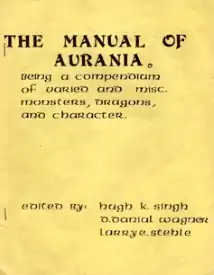The Manual of Aurania
The Manual of Aurania is a supplement for fantasy role-playing games published by International Gamers Association in 1977.

Contents
The Manual of Aurania is an unlicensed Dungeons & Dragons supplement of over 50 new monsters, nine dragons, character classes, and tables for random reincarnation.[1]
The new character classes included:
- Beorning
- Sidhe
- Samurai
- Basadae
- Leprechaun
- Shape-Shifter
- Cleric of Mitra
- Cleric of Asgard (either Thor or Odin)
The new monsters included seven new types of giants, five trolls, nine types of undead, eight dragons, six demons, and 22 miscellaneous creatures.
Publication history
In 1974, when TSR published Dungeons & Dragons, one of the earliest adopters was Aero Hobbies, a games store in Santa Monica, California owned by Gary Switzer. A large D&D group quickly formed and played regularly, developing a world called "Aurania", and several new variant rules and monsters. Someone in the group came up with the idea for a new character class based on lock-picking skills. One of the players, Daniel Wagner, later recalled, "One group had a dwarf who wanted to try picking locks with his dagger, so I had the idea for a Burglar class, which we drew up like a Magic user but with skills (like Lock picking) instead of spells. The consensus was to call the class 'Thief'." Wanting to share this news, store owner Switzer called Gary Gygax at TSR and described the thief class. Gygax subsequently developed the fourth official character class for D&D called the "thief", and published an early version in the independent games zine Great Plains Game Players Newsletter, crediting "Gary Schweitzer" of "sunny California" for the idea.[2]
Back at Aero Hobbies, news of the article did not travel as far as Santa Monica, and Switzer did not tell the group he had shared the group's idea with Gygax, so when the new Thief class appeared in the first D&D supplement, Greyhawk, the group assumed Gygax had stolen their idea. Their response was to write The Manual of Aurania, a collection of all of the new rules and monsters their group had developed. In the introduction, the authors claimed that several of their original concepts had been "stolen outright", and the purpose of the book was "to prevent this from happening again".
Manual of Aurania was written by Hugh K. Singh, D. Daniel Wagner, and Larry E. Stehle, with artwork by Troy Hughes and Aimee Karklyn. The Aero Hobbies group printed 200 copies of the 30-page book in 1977; a second printing of 1,000 copies, with typos corrected, was published by International Gamers Association in 1978.[1]
The original developer of the Thief class, Darrold Daniel Wagner, later related that when he met Gary Gygax at a convention, Gygax contended that the unlicensed Manual of Aurania was intellectual property theft, and threatened to sue. When Wagner reminded him of the origin of the Thief class, Gygax relented, saying, "One good steal deserves another."
Shannon Appelcline noted how the International Gamers Association had a close connection with Grimoire Games and through its short-lived partnership was doing distribution for them out of Long Beach, and that "Through this connection, Grimoire ended up associated with two other Californian "generic FRP" supplements that were also being distributed by IGA: The Manual of Aurania (1977, 1978) and Wizard's Aide (1977)."[3]:324
The Aero Hobbies group finished a second book, Libram of Aurania, but it was never published.
Reception
In the December 1978–January 1979 edition of White Dwarf (Issue #10), Don Turnbull was not taken with the new character classes, saying, "it seems to me that most, if not all these new creations are stronger than they should be, with no corresponding increase in weak points." Likewise he was not enthusiastic about the variant reincarnation rules, pointing out that dead characters had the same chance of returning as either a powerful gold dragon or as a lowly gnome. But he was impressed by the sixty new monsters presented, commenting, "It is in this section that I think most readers will find their main interest lies." He concluded "On the whole, it's not a bad booklet and a reasonable buy for the money" and gave the book a rating of 4 out of 10.[4]
References
- Schick, Lawrence (1991). Heroic Worlds: A History and Guide to Role-Playing Games. Prometheus Books. p. 171. ISBN 0-87975-653-5.
- "The History of Traps in Dungeons & Dragons". dmdavid.com. 2019-04-09. Retrieved 2020-06-27.
In the May 1974 issue of a fanzine called the Great Plains Games Players Newsletter, Gary Gygax presented the thief class. In his introduction, Gary tells how the class was suggested by a gamer named Gary Schweitzer (probably Santa Monica gamer Gary Switzer). “He mentioned that his group was developing a new class of character—thieves. Gary gave me a few details of how they were considering this character type, and from these I have constructed tentative rules for the class.”
- Shannon Appelcline (2014). Designers & Dragons: The '70s. Evil Hat Productions. ISBN 978-1-61317-075-5.
- Turnbull, Don (December 1978 – January 1979). "Open Box". White Dwarf. Games Workshop (Issue 10): 17.